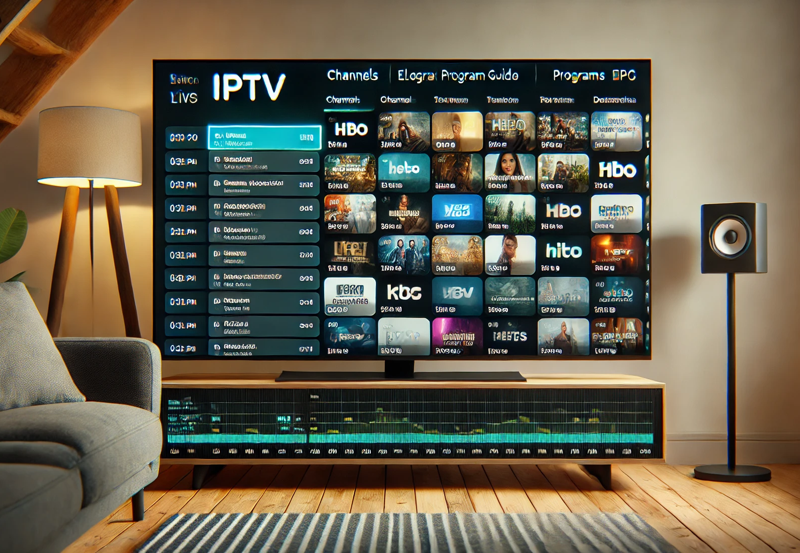The thrill of watching high-definition content on IPTV becomes even better with 4K resolution, offering unparalleled clarity and detail. However, to experience truly seamless 4K streaming, it’s essential to optimize your setup. Here’s a comprehensive guide to ensure you enjoy 4K IPTV without any buffering or interruptions.
Buy 1 Year IPTV – Instant Access
1. Check Your Internet Speed
Streaming in 4K requires a high-speed internet connection for uninterrupted playback. Ensuring your connection meets the minimum requirements for 4K is the first step toward optimal streaming.
- Recommended Speed: For 4K streaming, aim for at least 25 Mbps per device.
- Wired Connection: Connect your IPTV device directly to the router using an Ethernet cable to reduce lag and enhance stability.TiviMate Advanced Settings: Optimize Your IPTV Viewing Experience
- Wi-Fi Setup: If Ethernet isn’t an option, make sure your router is capable of high-speed Wi-Fi (preferably dual-band or tri-band) and keep your device within a reasonable range to minimize interference.
2. Optimize Router Settings for Better Performance
Your router plays a crucial role in managing network traffic and ensuring smooth data flow, especially for high-bandwidth tasks like 4K streaming.
- Enable QoS (Quality of Service): Most modern routers have QoS settings that prioritize traffic for specific devices or applications. Set your IPTV device as a priority to ensure it gets the necessary bandwidth.
- Upgrade Firmware: Check for any firmware updates for your router, as these often improve performance and fix known issues.
- Use a Dedicated Network: Consider creating a dedicated guest network solely for IPTV streaming. This way, other devices won’t interfere with your IPTV connection.
3. Configure IPTV App Settings
Many IPTV apps offer options to adjust video settings and buffering. Setting these up correctly can significantly improve your streaming quality.
- Enable Adaptive Streaming: This feature automatically adjusts video quality based on your internet speed. If your connection temporarily dips, adaptive streaming will lower the quality to prevent buffering.
- Increase Buffer Size: Go to the settings within your IPTV app and increase the buffer duration. A higher buffer size provides smoother playback, especially for 4K content.
- Select the Optimal Video Format: Some apps allow you to choose formats like H.265 (HEVC), which uses less bandwidth for 4K streaming while maintaining quality.
4. Invest in a High-Quality Streaming Device
The device you use for IPTV streaming plays a huge role in performance. Choosing a reliable streaming device or set-top box ensures that 4K content runs smoothly.
- Recommended Devices: Consider using devices optimized for 4K, such as Nvidia Shield TV, Amazon Fire TV Stick 4K, or Apple TV 4K. These are designed to handle high-resolution content without lag.
- Storage and Processing Power: Devices with faster processors and more storage handle 4K content more efficiently, reducing the risk of buffering.
5. Use a VPN (If Necessary)
Some ISPs throttle bandwidth for streaming, which can disrupt 4K content. A VPN (Virtual Private Network) can help bypass these limitations, providing consistent speeds.
- Choose a High-Speed VPN: Not all VPNs are built for streaming, so select one with dedicated high-speed servers optimized for streaming.
- Select a Server Close to Your Location: This minimizes the latency added by the VPN, ensuring smooth streaming.
6. Adjust TV and Display Settings
To experience the full effect of 4K, your TV or display settings must be properly configured.
- Resolution Settings: Ensure your TV is set to 4K resolution. This is typically automatic, but you may need to verify this in your TV’s settings.
- Enable HDR: If your content supports HDR (High Dynamic Range), activate it for more vivid colors and improved contrast.
- Optimize Display Mode: Some TVs have specific modes (like Cinema Mode or Game Mode) that enhance streaming performance, so try different modes to find the best one for IPTV.
7. Maintain Regular Device and App Updates
To keep everything running smoothly, ensure that both your IPTV app and streaming device are up-to-date.
- Update Apps: App updates often contain optimizations for performance, particularly when dealing with new codecs or 4K content support.
- Update Device Firmware: Like apps, devices also receive firmware updates that improve performance and compatibility.Advanced MAG Box IPTV Settings to Maximize Performance
8. Troubleshooting Common 4K Streaming Issues
Here are some quick fixes for issues that may arise when streaming in 4K:
- Buffering: If you encounter buffering, lower the video quality temporarily, or increase the buffer duration in the app.
- Audio Sync Issues: If audio and video are not aligned, go into your IPTV app’s audio settings and adjust the sync manually.
- Image Distortion: Check HDMI cables if you’re experiencing image quality issues. Ensure that you’re using high-speed HDMI cables that support 4K.
Conclusion
Optimizing your 4K IPTV setup doesn’t have to be complicated. By focusing on your internet connection, router settings, app configurations, and device quality, you can enjoy a seamless, high-quality streaming experience. With these steps, you’re ready to transform your IPTV setup into a true 4K streaming powerhouse, ensuring that your entertainment is free from interruptions and ready for the future of ultra-high-definition content.





